Towers are the anchors for every one of my play structures. When I start to design a new play structure, one of the first decisions is what type of tower? Should it be open or closed? How large? Square or a multi-sided polygon? What type of polygon would fit best? And how many towers?
It’s the play area that often determines the type and number of towers: for example, a rectangular tower may fit a long narrow space better than a square one. But equally important is what the family has dreamed of: A pirates’ ship? An octagon castle? A big roomy clubhouse up high?
A tower is a two-story structure that defines the look and functionality of the play structure. It’s my fun job to blend all of the above concerns and come up with the perfect tower that anchors the family’s backyard play structure.
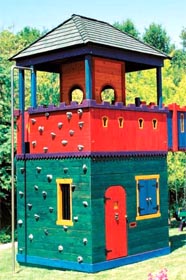
The Square Tower
The Square Tower is a favorite for a reason: it is practical, economical and looks great in any landscape. There’s something sturdy and unpretentious about a square tower. The square tower gives four solid sides for activities: a big rock wall, a bridge, a slide, a doorway with lookout cut-outs above.
Our smallest square tower is 4’ wide by 4’ wide. I’ve seen 6 kids hanging out in a 4x4 quite comfortably.
The Robin Hood’s fort is 4-1/2’ x 4-1/2’ and it boasts a secret escape out the back under the bench.
The Atherton Castle, pictured here, is 7’ x 7’. That’s big enough to include an inside ladder that breaks through the second floor deck and lets the kids scramble up to the upper levels.
Another benefit of the square tower is the roof options: it can be topped with a pyramidal roof or gable roof.

Rectangular Tower
The rectangular tower lets you go bigger without looking too massive. I like to stretch the size of the tower according to your space: The King Fort with its rectangular shape is the perfect example: the play space was longer than it was wide, so I stretched the fort across the width to make it rectangular. The two extra-big sides of the fort makes space for a window next to the door as well as an extra large rock wall. Inside there’s more square footage than a square tower. That extra space is great for having sleepovers - especially since Mom and Dad will probably be sleeping out there also!

Octagon Towers
Most people agree that the Octagon Towers are the most beautiful. The eight-sided towers have grace and symmetry, and you can have eight different activities on one tower! My favorite way to make an Octagon Tower is to cover all sides with rock climbing holds so that kids can circumnavigate the octagon ( “bouldering”.) Bouldering really build muscles and rock-climbing skills. Also, with rock climbing all over, the kids can storm the castle from eight different points.
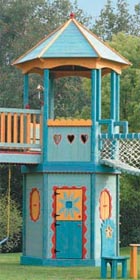
Hexagon Tower
The Hexagon Tower and Octagon Tower often look similar from a distance. I generally suggest the 6-sided Hexagon Tower when its angles work better for the placement in the yard. For example, sometimes only a Hexagon Tower will work to fit the bridge-over-swings into a specific play space. The Hexagon Tower also gives you a larger side wall than the same size Octagon Tower.
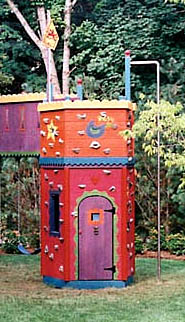
Pentagon Tower
The Pentagon Tower almost always looks like a Square tower in a photograph, but not in real life. I love the playful nature of the Pentagon Tower: you walk up to the tower, thinking it’s a square tower, but suddenly you realize someone put an extra wall in there! Often the Pentagon Tower is the perfect solution to a design problem: the slide needs to come off the tower at a slight angle to fit or the family really wants one more activity but not a another tower.

Multi-Faceted Towers
Le Petit Chalet is one of many Multi-Faceted Towers. These towers are marked by a variety of rooms and roofs. Very charming to look at and fun to run around inside! Often they have a maze-like quality inside: room leading into room, suddenly a ladder up, then another room… Le Petit Chalet is a perfect balance of playhouse and play structure. There’s plenty of room to have tea parties, but there’s also rock climbing, ladders, and a rope net for rough and tumble activity. Once you’re up there, there’s also a balcony with a fast slide down. It’s a riot of doors and shutters and multiple levels!
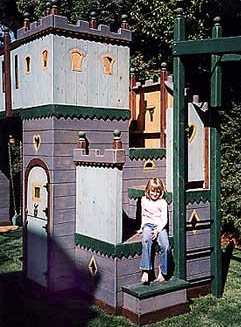
The Stacking Fort
The Stacking Fort is the smallest of the multi-faceted towers. The Stacking Fort was invented a long ago when a client asked for an easy way up to the bridge and then over to the main tower. The big steps are easy enough for both small kids and adults, but they still feel fun! Below the big steps is a playhouse that’s a bit of a maze. There’s a front door , a window, a secret escape door and a secret storage spot under the second step, with lots of cut-outs all around for spying and surprising. The The Stacking Fort pictured here also acts as a take-off platform for the Hand-over-Hand bars.
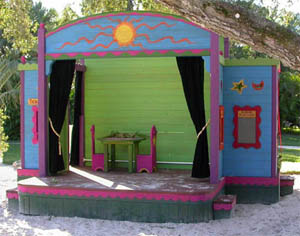
Theater
It’s hard to say who gets more pleasure out of a backyard Theater: the kids putting on the play or the parents watching it. When I was a kid, we were constantly staging plays and I always thought the rehearsals were even more fun than the actual performances (which were often plagued with technical difficulties!) The Sunshine Theater covers all aspects of theater life: a great front stage, a fun backstage area with places to hang costumes and store props, a ticket booth, chalkboard billboards and a mailbox for fan mail. The show must go on!
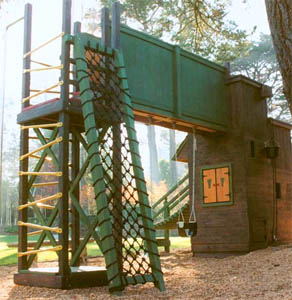
Climbing Towers
Climbing Towers are great anchors for the bridges. Instead of adding a single climbing feature to the end of a bridge, the Climbing Tower is an affordable way to add more features, while also giving the bridge a strong, sturdy anchor as well. It’s only 3 feet square and it’s designed to work with almost all the play features we offer. The climbing tower in the photo of the Tree Side Fort has double crazy bar climbs, a firepole as well as a rope net. You could decide instead to add a ship’s ladder or a slide or another bridge: there are plenty of possibilities!

Ship Tower
Who can resist sailing the high seas with a tower that’s also a Ship? There something wonderful about having a ship in your backyard – just a glance of it out your kitchen window can take you far away. Kids love playing sea captain or pirate or explorer, using the ship’s wheel, the pirate’s flag and the crow’s nest. But I try to also add play features to a ship to make it a great play structure as well: slide, firepole, rock climbing, rope net. I believe the combination of imaginative play with physical play is key to making a great play structure.
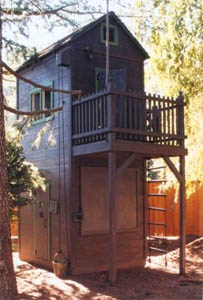
Closed Clubhouse
A tower with four solid walls up top can be either a Closed Clubhouse or a Double Playhouse.
The Closed Clubhouse is for older kids. They really like the idea of having a waterproof roof and four solid walls. This clubhouse has built-in cupboards and shelves as well as a drop-leaf table and benches set. The side wall has rock climbing which takes the kids up the wall and through the window. Also there’s a door that opens to a firepole. Totally geared towards the older kid crowd!
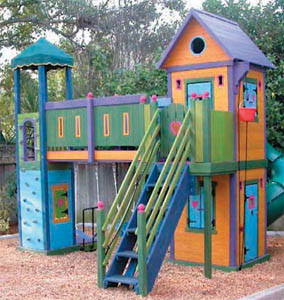
Double Playhouse
The Double Playhouse is similar but geared more towards younger kids. The upper windows have decorative metal window grates so the kids can’t climb out the window. There’s a slide off the back wall but everything is enclosed so parents don’t have to worry about the little ones exploring up there.
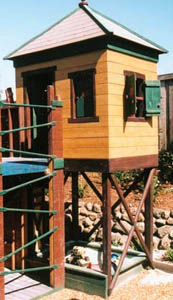
Playhouse On Stilts
The Western Fort is a great example of Playhouse On Stilts. The playhouse sits above the sandbox, providing shade for the sandbox area. The kids love this: both a playhouse and a lookout tower! The X-bracing not only makes the structure incredibly strong, it’s looks great as well. It doesn’t have to be a sandbox below: you could have a swinging bench, a table and two benches, a disc swing or we could hang some curtains and a floor and turn it into a small theater…
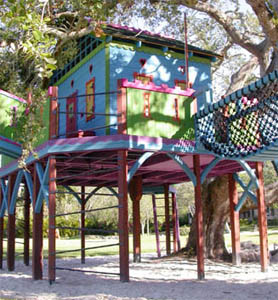
Large Deck w/ Clubhouse on top
The Tropical Treehouse is an example of a Large Deck with a Clubhouse on top. The deck is huge: 15’ x 18’ and the 8’ x 12’ clubhouse sits on top of it, leaving a walkway all around the clubhouse. That creates an incredible play space above – kids run in and out of the clubhouse and round and round the deck. It also creates a fun place below that’s cool and shaded: a place for rings and hand-over-hand bars and just hanging out. Notice the extra-large metal crazy bar climbs as well. Big decks like this are built in our shop in three panels and then bolted together on site.

Stump Houses
Sometimes when a play area is selected and the health of the trees is examined, it is discovered that a tree needs to come down for safety reasons. That’s when I ask for the tree stump to be left tall and the tree stump to become a part of the play area!
Stump Houses are playhouses or clubhouses that are built on sturdy tree stumps. Canyon Perch is an example of a dramatic play structure designed around a 4’ diameter eucalyptus tree. Fort Autumn also has a couple of dramatic stump houses. The Perched Playhouse is just pretending to be a stump house: the old walnut tree stump couldn’t be counted on to actually support the tree. The kids really wanted a treehouse, so I made it look like the walnut tree is holding up the deck, but really the four redwood 6x6 posts are doing the work.